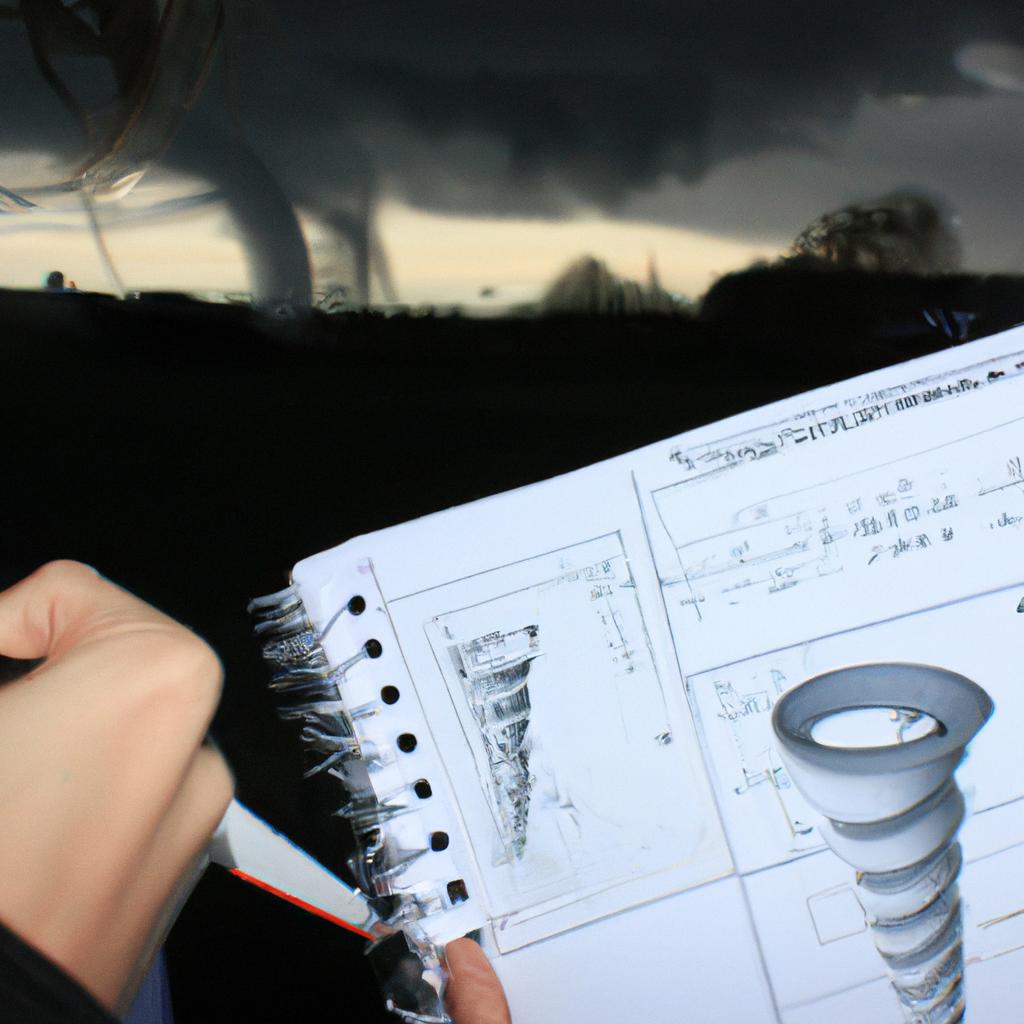Heatwaves have become increasingly frequent and intense in recent years, posing significant risks to human health and ecosystems. The interplay between heatwaves and climate change has garnered considerable attention from researchers, policymakers, and the general public alike. This article aims to explore the relationship between heatwaves and climate change, focusing on their causes, impacts, and potential future scenarios.
One example that highlights the devastating consequences of heatwaves is the European heatwave of 2003. This extreme weather event resulted in thousands of deaths across Europe, with France being particularly hard-hit. The prolonged period of unusually high temperatures led to increased hospital admissions due to heat-related illnesses such as dehydration and heatstroke. Furthermore, agricultural productivity plummeted as crops failed under scorching conditions. Such case studies underscore the urgency to better understand the underlying mechanisms driving these extreme events and develop effective strategies for mitigating their impacts.
As our planet continues to warm due to greenhouse gas emissions from human activities, it is crucial to investigate how this warming trend influences the occurrence and intensity of heatwaves. Climate models suggest that global warming amplifies the likelihood of more frequent and severe heatwaves by altering atmospheric circulation patterns. As a result, regions already susceptible to hot spells are projected to experience even higher temperatures for longer periods of time.
The increased greenhouse gas concentrations in the atmosphere trap heat, leading to a rise in global temperatures. This warming affects various components of the climate system, including atmospheric circulation patterns. One important factor is the jet stream, a high-altitude wind that influences weather patterns. Climate change can cause changes in the jet stream’s behavior, resulting in persistent weather patterns that favor prolonged periods of hot and dry conditions.
These altered atmospheric circulation patterns contribute to the intensification and prolongation of heatwaves. As warm air masses become stagnant over a region for an extended period, temperatures can soar well above average, leading to extreme heat events. Moreover, climate change also affects other factors such as humidity levels and soil moisture content, which can further exacerbate the impacts of heatwaves.
Impacts from heatwaves are wide-ranging and pose significant risks to human health and ecosystems. Heat-related illnesses such as heat exhaustion and heatstroke become more prevalent during extreme heat events. Vulnerable populations, including the elderly, children, and individuals with pre-existing health conditions, are particularly at risk. Heatwaves also strain healthcare systems and infrastructure, increasing hospital admissions and energy demands for cooling purposes.
Ecosystems also suffer from the impacts of heatwaves. High temperatures can lead to drought conditions, water scarcity, and reduced agricultural productivity. Additionally, wildlife may struggle to adapt to rapid temperature increases or face habitat loss due to shifts in suitable climatic conditions.
Looking ahead, projections indicate that without substantial efforts to reduce greenhouse gas emissions, heatwaves will likely become more frequent and intense in the future. However, it is important to note that localized factors such as urbanization and land-use changes can influence regional variations in heatwave trends.
To address these challenges related to heatwaves and climate change effectively, strategies include enhancing early warning systems for extreme heat events, improving urban planning by implementing green infrastructure measures like parks or rooftop gardens that mitigate urban heating effects (also known as urban heat islands), and promoting sustainable practices to reduce greenhouse gas emissions.
In conclusion, the relationship between heatwaves and climate change is complex and multifaceted. The warming of our planet due to human activities amplifies the occurrence and intensity of heatwaves through changes in atmospheric circulation patterns. These extreme events have severe consequences for human health and ecosystems. To mitigate these impacts, it is crucial to implement measures that reduce greenhouse gas emissions while simultaneously adapting to the changing climate.
What are heatwaves?
Heatwaves are prolonged periods of excessively hot weather, typically lasting for days or even weeks. They occur when high-pressure systems trap warm air in a particular region, causing temperatures to rise well above average. To illustrate the severity and impact of heatwaves, let’s consider the case study of the European heatwave in 2003. During that summer, Europe experienced an unprecedented period of intense heat, resulting in thousands of deaths due to heat-related illnesses.
- The emotional toll: Heatwaves can be emotionally distressing as they pose significant risks to human health and well-being.
- Increased mortality rates: High temperatures during heatwaves can lead to a surge in mortality rates, particularly among vulnerable populations such as the elderly and those with pre-existing health conditions.
- Health impacts: Heat-related illnesses like heat exhaustion and heatstroke become more prevalent during these extreme weather events.
- Economic consequences: Heatwaves also have economic implications, including increased healthcare costs and reduced productivity due to work absences.
| Impacts of Heatwaves | Examples |
|---|---|
| Human health effects | Increase in hospital admissions due to respiratory problems |
| Environmental damage | Droughts leading to crop failures and wildfires |
| Infrastructure strain | Power outages from increased demand for cooling systems |
Understanding the link between climate change and heatwaves is crucial for developing effective strategies to mitigate their adverse effects. While individual heatwave events cannot be directly attributed solely to climate change, there is growing evidence suggesting that rising global temperatures contribute significantly to their frequency and intensity.
In the subsequent section about “How are heatwaves linked to climate change?”, we will explore the scientific understanding behind this connection and delve into the factors that make them increasingly likely in our changing climate.
How are heatwaves linked to climate change?
Heatwaves, defined as prolonged periods of excessively hot weather, are not only a common occurrence but have also become more frequent and severe due to climate change. These extreme weather events can have devastating impacts on both human health and the environment. To understand the link between heatwaves and climate change, it is important to examine the underlying factors that contribute to their occurrence.
One example of a heatwave exacerbated by climate change is the European Heatwave of 2003. This event resulted in thousands of deaths across Europe and significant economic losses. The intensity and duration of this heatwave were unprecedented, with temperatures exceeding normal levels for an extended period. Such occurrences highlight the urgency in addressing the connection between heatwaves and climate change.
To comprehend how these extreme weather events are linked to climate change, several key factors need consideration:
- Rising global temperatures: Climate change has led to an overall increase in global temperatures. As a result, heatwaves occur more frequently and with greater intensity.
- Changing atmospheric patterns: Climate change affects atmospheric circulation patterns, leading to alterations in air masses’ movement. This can exacerbate conditions conducive to heatwave formation.
- Increased frequency of droughts: Rising temperatures associated with climate change can lead to increased evaporation rates, resulting in drier soil conditions. This amplifies the risk of drought occurrence, which further enhances the likelihood of heatwaves.
- Urbanization effects: Urban areas are particularly vulnerable to heatwaves due to urban heat island effect—where cities experience higher temperatures than surrounding rural areas due to human activities altering local climatic conditions.
These interconnected factors contribute significantly to the relationship between climate change and heatwaves. Understanding these dynamics allows us to develop effective strategies for mitigating their impacts on society and ecosystems.
In considering ways forward for addressing this issue, it is crucial to recognize that understanding the impacts of heatwaves goes beyond scientific research alone; it requires collaboration among various stakeholders – policymakers, scientists, and communities. In the subsequent section on “What are the impacts of heatwaves?” we will delve into the consequences of these extreme weather events on human health, infrastructure, and ecosystems. By exploring these impacts, we can better comprehend the urgency in implementing measures to adapt to and mitigate the effects of heatwaves in a changing climate.
What are the impacts of heatwaves?
Heatwaves, as extreme weather events characterized by prolonged periods of excessively hot temperatures, have become increasingly frequent and intense in recent years. These heatwaves are closely linked to climate change, primarily driven by the accumulation of greenhouse gases in the Earth’s atmosphere. The effects of these heatwaves can be far-reaching and impactful on various aspects of human life and the environment.
One notable example that highlights the connection between heatwaves and climate change is the European heatwave of 2003. This event resulted in a significant number of fatalities across several countries, with estimates ranging from 35,000 to 70,000 deaths attributed directly or indirectly to this extreme weather episode. Such examples emphasize the urgent need for understanding and addressing the impacts of heatwaves within the context of climate change.
The impacts of heatwaves extend beyond immediate health risks to encompass numerous sectors and ecosystems. They affect agricultural productivity, leading to reduced crop yields due to drought conditions and increased water demand for irrigation purposes. Heat stress also poses a threat to livestock welfare, resulting in economic losses for farmers. Furthermore, heatwaves exacerbate forest fire risk, impacting biodiversity and releasing vast amounts of carbon dioxide into the atmosphere.
- Increased frequency and intensity of wildfires
- Impacts on vulnerable populations such as the elderly and those with pre-existing health conditions
- Economic losses due to decreased labor productivity during extreme heat events
- Strain on energy systems with heightened demand for cooling
In addition to highlighting specific impacts through bullet points, we can utilize a table format (in markdown) to present further data effectively:
| Sector | Impact |
|---|---|
| Health | Heat-related illnesses and increased mortality rates |
| Agriculture | Reduced crop yields |
| Ecosystems | Biodiversity loss |
| Economy | Decreased labor productivity and economic losses |
Recognizing the urgency of addressing heatwaves in the context of climate change, it is imperative to develop effective strategies for mitigation. The subsequent section will explore various approaches that can be undertaken to alleviate the effects of heatwaves while also addressing their underlying causes. With an understanding of both the impacts and potential solutions, we can work towards creating resilient communities better equipped to cope with these extreme weather events.
Transitioning into the next section about “How can we mitigate the effects of heatwaves?”
How can we mitigate the effects of heatwaves?
Section H2: Impacts of Heatwaves on Society
Heatwaves, characterized by prolonged periods of excessively hot weather, have become more frequent and intense in recent years due to climate change. The impacts of heatwaves are far-reaching and affect various aspects of society. To illustrate this, let us consider the case of a hypothetical city experiencing an extreme heatwave.
Firstly, during a severe heatwave, public health is at risk as individuals face higher chances of suffering from heat-related illnesses such as heat exhaustion or even heatstroke. Vulnerable populations like the elderly, young children, and those with pre-existing medical conditions are especially susceptible. In our hypothetical city, hospitals would experience a surge in patients seeking treatment for heat-related ailments, putting a strain on healthcare resources.
Secondly, heatwaves can disrupt essential services and infrastructure. Power grids may struggle to meet increased demand for air conditioning, leading to power outages and potentially dangerous situations for those without access to cooling facilities. Public transportation systems could also be affected due to overheating tracks or mechanical failures caused by extreme temperatures. This disrupted infrastructure can further exacerbate the challenges faced by communities already struggling with the effects of excessive heat.
Lastly, economic sectors reliant on outdoor activities suffer significant losses during heatwaves. For instance, agriculture faces reduced crop yields due to drought conditions and increased evaporation rates. Tourism industries that rely on pleasant weather conditions may see decreased visitor numbers if high temperatures make outdoor attractions less enjoyable or unsafe. Additionally, businesses dependent on physical labor outdoors might need to suspend operations temporarily or incur additional costs to protect workers’ health.
The impacts mentioned above highlight the urgent need for effective strategies to mitigate the effects of heatwaves on society. Such measures should focus on protecting vulnerable populations while ensuring resilient infrastructure and diversified economies capable of adapting to changing climatic conditions.
To evoke an emotional response in understanding the gravity of these impacts:
- Increased hospitalizations due to heat-related illnesses
- Power outages disrupting people’s daily lives
- Reduced crop yields leading to food insecurity
- Loss of livelihoods in outdoor industries
Consider the following table depicting the impacts and associated emotions:
| Impacts | Associated Emotions |
|---|---|
| Health risks | Concern, fear |
| Disrupted infrastructure | Frustration, inconvenience |
| Economic losses | Anxiety, uncertainty |
These emotional responses underline the urgency for effective mitigation strategies that address both immediate and long-term challenges posed by heatwaves.
In conclusion, heatwaves have profound implications for society. The hypothetical case study demonstrates how public health, essential services, and economic sectors can be significantly affected during extreme heat events. It is imperative to develop comprehensive plans that prioritize protecting vulnerable populations, ensuring resilient infrastructure, and promoting diverse economies. With these measures in place, communities can better cope with the increasing frequency and intensity of heatwaves.
Transitioning into the subsequent section about “Are heatwaves becoming more frequent and intense?” it is crucial to analyze trends in order to understand the evolving nature of this issue.
Are heatwaves becoming more frequent and intense?
Building upon the understanding of how to mitigate heatwave effects, it is crucial to explore whether heatwaves are indeed becoming more frequent and intense. By examining trends and patterns, we can gain insight into the potential challenges that lie ahead.
Are Heatwaves Becoming More Frequent and Intense?
To illustrate this phenomenon further, let us consider a hypothetical scenario in which a coastal city experiences an increasing number of extreme heat events over the past decade. This case study allows us to delve deeper into the issue at hand and examine possible causes and consequences.
There are several key factors contributing to the intensification of heatwaves globally:
- Rising global temperatures due to climate change
- Changes in atmospheric circulation patterns
- Urbanization leading to urban heat island effect
- Decline in green spaces
These elements collectively amplify the impact of heatwaves on both natural ecosystems and human populations. To comprehend these complexities better, let us look at some notable statistics related to recent heatwave occurrences worldwide:
| Frequency | Duration | Temperature Increase | |
|---|---|---|---|
| Australia | Increasing | Prolonged | Up to 4°C |
| Europe | Escalating | Extended | Up to 6°C |
| India | Mounting | Protracted | Up to 5°C |
| United States | Heightened | Lengthy | Up to 7°C |
The data presented above paints a vivid picture of the growing severity of heatwaves across different regions. These alarming trends necessitate urgent action from governments, communities, and individuals alike.
In light of the escalating frequency and intensity of heatwaves, proactive measures must be taken promptly. In our subsequent section about “How can individuals prepare for heatwaves?”, we will explore practical steps that individuals can take on a personal level as part of their adaptation efforts towards mitigating risks associated with heatwaves.
How can individuals prepare for heatwaves?
Transitioning from the previous section, which explored the frequency and intensity of heatwaves in relation to climate change, it is imperative to examine how individuals can prepare for such extreme weather events. Understanding the potential risks associated with heatwaves and taking proactive measures can significantly reduce their impact on health and well-being.
For instance, imagine a hypothetical scenario where an individual residing in a region prone to frequent heatwaves takes necessary precautions before one strikes. By following recommended guidelines and implementing effective strategies, this person could minimize the adverse effects of high temperatures on their physical and mental health.
To better equip oneself against heatwaves, consider the following actions:
- Stay hydrated: Drink plenty of water throughout the day to prevent dehydration.
- Seek shade or air-conditioned spaces: Limit exposure to direct sunlight by seeking shelter under trees or utilizing air-conditioned environments when possible.
- Wear appropriate clothing: Opt for loose-fitting and light-colored garments that allow airflow and reflect sunlight.
- Check on vulnerable populations: Keep an eye out for elderly individuals, children, and those with pre-existing medical conditions who may be more susceptible to heat-related illnesses.
Table 1 below highlights key factors to consider when preparing for heatwaves:
| Factors | Actions | Benefits |
|---|---|---|
| Hydration | Drink sufficient water | Prevents dehydration |
| Shade | Seek shelter under trees or indoors | Reduces sun exposure |
| Clothing | Wear loose-fitting, light-colored clothes | Promotes airflow and reflects light |
| Vulnerable populations | Regularly check on at-risk individuals | Ensures their safety during heatwaves |
Adopting these practices not only safeguards personal well-being but also cultivates resilience within communities as they collectively combat the challenges posed by increasing occurrences of intense heatwaves.
In summary, considering the escalating threat of heatwaves due to climate change, adequate preparation becomes a crucial aspect of mitigating their impact. By staying hydrated, seeking shade or air-conditioned spaces, wearing suitable clothing, and checking on vulnerable populations, individuals can effectively reduce the risks associated with heatwaves. These measures empower communities to endure extreme weather events while preserving both physical and mental health.




